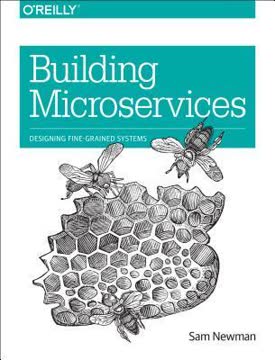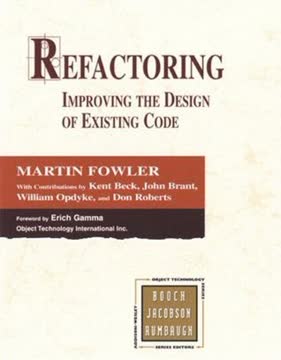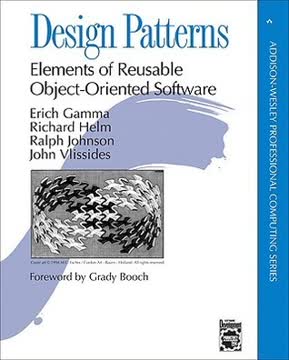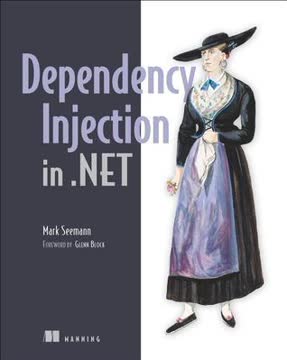Key Takeaways
1. Dependency Injection enables loose coupling for maintainable code
Dependency Injection is a set of software design principles and patterns that enable us to develop loosely coupled code.
Loose coupling benefits. Dependency Injection (DI) promotes modular design by reducing dependencies between components. This leads to several advantages:
- Improved maintainability: Changes in one module have minimal impact on others
- Enhanced testability: Components can be easily isolated for unit testing
- Greater flexibility: Implementations can be swapped without modifying consumers
- Parallel development: Teams can work on different modules simultaneously
DI achieves this by inverting control of dependencies. Instead of components creating their own dependencies, they receive them from external sources. This separation of concerns allows for more flexible and adaptable software architectures.
2. SOLID principles guide effective object-oriented design
Program to an interface, not an implementation.
SOLID explained. The SOLID principles provide a foundation for creating maintainable object-oriented systems:
- Single Responsibility Principle: A class should have only one reason to change
- Open/Closed Principle: Classes should be open for extension but closed for modification
- Liskov Substitution Principle: Subtypes must be substitutable for their base types
- Interface Segregation Principle: Many client-specific interfaces are better than one general-purpose interface
- Dependency Inversion Principle: Depend on abstractions, not concretions
These principles work together to create loosely coupled, highly cohesive systems. They guide developers in creating flexible designs that can easily accommodate change and growth over time. By adhering to SOLID, you create a solid foundation for implementing Dependency Injection effectively.
3. Constructor Injection is the preferred method for implementing DI
Constructor Injection should be your default choice for DI.
Benefits of Constructor Injection.
- Ensures dependencies are available immediately after object creation
- Makes dependencies explicit in the class's public API
- Supports immutability by allowing readonly fields
- Works well with DI containers and facilitates easier testing
Constructor Injection involves passing dependencies as parameters to a class's constructor. This approach has several advantages over other injection methods like Property Injection or Method Injection. It guarantees that an object is in a valid state as soon as it's constructed, preventing the possibility of using an object before all its dependencies are set. Additionally, it makes the class's dependencies clear to consumers, improving code readability and maintainability.
4. Composition Root centralizes object graph creation
The Composition Root is a (preferably) unique location in an application where modules are composed together.
Implementing Composition Root. The Composition Root pattern addresses where and how to compose object graphs:
- Located as close to the application's entry point as possible
- Centralizes all object composition logic
- Separates object creation from object use
- Facilitates easier configuration changes and testing
By centralizing object composition, the Composition Root pattern simplifies dependency management and makes it easier to change implementations or configurations without affecting the rest of the application. This separation of concerns allows the majority of the codebase to focus on business logic rather than object creation and wiring.
5. DI Containers simplify dependency management
A DI Container is a library that can automate many of the tasks involved in composing objects and managing their lifetimes.
DI Container benefits. While not required for implementing DI, containers offer several advantages:
- Automate object graph composition
- Manage object lifetimes (e.g., singleton, transient, per-request)
- Support declarative configuration (XML, code, or convention-based)
- Facilitate easier testing and mock object substitution
- Often provide additional features like interception and aspect-oriented programming
DI Containers handle the complex task of creating and managing object graphs based on configured rules. This automation reduces boilerplate code and allows developers to focus on business logic rather than dependency management. However, it's important to use containers judiciously and not let them become a crutch that leads to Service Locator anti-patterns.
6. Proper lifetime management prevents resource leaks
DI gives us an opportunity to manage Dependencies in a uniform way.
Lifetime management strategies. Different components may require different lifetime management approaches:
- Singleton: One instance for the entire application lifetime
- Transient: New instance created for each request
- Per-request (web applications): One instance per HTTP request
- Pooled: Reuse instances from a pre-configured pool
Proper lifetime management is crucial for preventing resource leaks and ensuring optimal performance. DI Containers often provide built-in support for various lifetime strategies, simplifying this aspect of dependency management. It's important to consider the thread-safety and resource usage characteristics of components when choosing appropriate lifetime strategies.
7. Anti-patterns to avoid when implementing Dependency Injection
A DEPENDENCY cycle is a design smell. If one appears, you should seriously reconsider your design.
Common DI anti-patterns. Awareness of these pitfalls helps create better designs:
- Control Freak: Class creates its own dependencies instead of accepting them
- Service Locator: Using a service locator instead of proper DI
- Constrained Construction: Requiring specific constructors for all dependencies
- Bastard Injection: Mixing DI with direct instantiation of dependencies
Avoiding these anti-patterns is crucial for reaping the full benefits of Dependency Injection. They often indicate a misunderstanding of DI principles or an attempt to retrofit DI onto an existing tightly-coupled design. Recognizing and refactoring these patterns leads to more maintainable and flexible code.
8. Refactoring strategies for introducing DI into existing code
Refactoring to Facade Services is more than just a party trick to get rid of too many Dependencies.
Refactoring techniques. Introducing DI to legacy code requires careful refactoring:
- Extract Interface: Create abstractions for existing concrete classes
- Extract Method: Break down large methods to identify dependencies
- Introduce Parameter: Convert hard-coded dependencies to method parameters
- Replace Constructor with Factory Method: Facilitate easier dependency injection
- Introduce Facade Services: Aggregate multiple dependencies into higher-level abstractions
Refactoring existing code to use DI can be challenging but offers significant long-term benefits. It's often an incremental process, starting with the most problematic or frequently changing areas of the codebase. Using automated refactoring tools and maintaining a comprehensive test suite helps ensure the safety of these transformations.
9. Framework-specific techniques for applying DI
Use a proper DI Container instead of developing your own lifetime-tracking code.
Framework integration. Different frameworks require specific approaches for DI integration:
- ASP.NET MVC: Implement custom controller factories
- WCF: Use custom ServiceHostFactory and IInstanceProvider implementations
- WPF: Override Application.OnStartup for composition
- Console applications: Compose object graphs in the Main method
Each framework has its own lifecycle and composition model, requiring tailored approaches for effective DI implementation. Understanding these framework-specific nuances is crucial for seamlessly integrating DI into different types of applications. Many DI Containers provide framework-specific extensions or integrations to simplify this process.
10. Advanced DI concepts: Interception and Aspect-Oriented Programming
Interception is an application of the Decorator design pattern.
Advanced DI techniques. Beyond basic dependency management, DI enables powerful programming paradigms:
- Interception: Modify or enhance the behavior of objects without changing their code
- Decorators: Add responsibilities to objects dynamically
- Proxies: Control access to objects
- Aspect-Oriented Programming (AOP): Modularize cross-cutting concerns
These advanced techniques allow for powerful composition and modification of behavior without changing existing code. They're particularly useful for implementing cross-cutting concerns like logging, caching, or security. Many DI Containers provide built-in support for interception and AOP, further extending the capabilities of DI beyond simple object composition.
Last updated:
FAQ
What's Dependency Injection in .NET about?
- Focus on DI: Dependency Injection in .NET by Mark Seemann is a comprehensive guide to understanding and implementing Dependency Injection (DI) in .NET applications. It emphasizes DI as a set of principles and patterns for creating loosely coupled code.
- Purpose and Benefits: The book highlights the importance of maintainability in software development, explaining how DI contributes to writing maintainable code by promoting loose coupling.
- Practical and Framework Agnostic: It includes practical examples and case studies, making it easier for developers to apply DI concepts in real-world scenarios. The principles are applicable across different frameworks and languages.
Why should I read Dependency Injection in .NET?
- Expert Insights: Authored by Mark Seemann, a seasoned software architect, the book offers valuable insights and best practices in DI and software design.
- Improves Code Quality: By learning DI, readers can improve the quality and maintainability of their code, which is essential for long-term software projects.
- Comprehensive Coverage: It covers a wide range of topics, from basic DI concepts to advanced techniques, making it suitable for both beginners and experienced developers.
What are the key takeaways of Dependency Injection in .NET?
- Understanding DI: Readers will gain a solid understanding of what DI is, its purpose, and how it can be applied to create maintainable software.
- DI Patterns and Anti-Patterns: The book outlines key DI patterns, such as Constructor Injection, and highlights common anti-patterns like Control Freak and Service Locator.
- SOLID Principles: It emphasizes the importance of SOLID principles in software design, particularly how DI helps achieve these principles, such as the Single Responsibility Principle and Open/Closed Principle.
What are the best quotes from Dependency Injection in .NET and what do they mean?
- "CONTROL FREAK is the antithesis of INVERSION OF CONTROL.": This quote emphasizes that tightly controlling the creation of dependencies leads to rigid code, which contradicts DI principles that promote flexibility and loose coupling.
- "Code is a liability.": This highlights the idea that code can become a burden if not managed properly, underscoring the importance of clean, maintainable design practices like DI.
- "Fail fast.": This phrase encapsulates the Circuit Breaker pattern's philosophy, encouraging developers to detect failures early and respond appropriately to prevent cascading issues in applications.
How does Dependency Injection in .NET define Dependency Injection?
- Set of Principles: Dependency Injection is defined as "a set of software design principles and patterns that enable us to develop loosely coupled code."
- Means to an End: The book emphasizes that DI is not an end goal but a means to achieve maintainable software, focusing on the importance of loose coupling.
- Framework for Understanding: It provides a framework for understanding how to structure code to solve common problems in software design.
What is Constructor Injection as described in Dependency Injection in .NET?
- Primary DI Pattern: Constructor Injection is the most important DI pattern, where dependencies are provided through a class's constructor, ensuring they are available when needed.
- Guarantees Dependency Availability: This method guarantees that the required dependencies are present, as the compiler enforces that they must be supplied when creating an instance of the class.
- Promotes Loose Coupling: By requiring dependencies to be passed in, it promotes loose coupling and makes the code easier to test and maintain.
How does Dependency Injection in .NET suggest managing object lifetimes?
- Lifetime Management: The book discusses the importance of managing the lifetimes of dependencies to avoid resource leaks and ensure proper cleanup.
- DI Containers: It explains how DI containers can help manage object lifetimes, allowing for different lifestyles such as Singleton, Transient, and Scoped.
- Best Practices: The author provides best practices for implementing lifetime management effectively within the context of DI.
What is the Composition Root concept in Dependency Injection in .NET?
- Centralized Composition: The Composition Root is defined as the unique location in an application where all modules are composed together, ideally as close to the application’s entry point as possible.
- Encapsulation of DI Logic: This pattern encapsulates all DI logic, ensuring that the rest of the application remains unaware of the DI container, thus promoting loose coupling.
- Single Responsibility: By centralizing the composition, it adheres to the Single Responsibility Principle, allowing for easier maintenance and testing of the application.
What are the common anti-patterns discussed in Dependency Injection in .NET?
- Control Freak: This anti-pattern occurs when dependencies are controlled directly, preventing proper DI and leading to tightly coupled code.
- Service Locator: Another common anti-pattern, the Service Locator provides dependencies implicitly, which can obscure the code's intent and lead to maintenance challenges.
- Bastard Injection: This involves using foreign defaults for dependencies, which can lead to unexpected behavior and complicate the codebase.
How does Dependency Injection in .NET address error handling?
- Error Handling Strategies: The book discusses various strategies for handling errors in applications that use DI, emphasizing the importance of separating error handling from business logic.
- Decorator for Error Handling: An example is provided where an ErrorHandlingInterceptor is implemented as a Decorator, which catches exceptions thrown by the decorated service and provides user-friendly error messages.
- Best Practices: The author advocates for using DI to implement error handling in a way that adheres to the Single Responsibility Principle, ensuring that error handling logic is modular and reusable.
How does Dependency Injection in .NET recommend configuring DI containers?
- XML Configuration: The book discusses using XML for configuring DI containers, which allows for late binding but can be verbose and error-prone.
- Code as Configuration: It also advocates for using code to configure DI containers, which provides compile-time checks and is generally more concise.
- Auto-Registration: The concept of Auto-Registration is introduced, allowing for automatic mapping of abstractions to concrete types based on conventions, reducing boilerplate code.
How does Dependency Injection in .NET relate to SOLID principles?
- Single Responsibility Principle: DI encourages classes to have a single responsibility by allowing them to focus on their core functionality while delegating dependency management to the DI container.
- Open/Closed Principle: DI enables classes to be open for extension but closed for modification, as new behaviors can be added through decorators or new implementations without changing existing code.
- Liskov Substitution Principle: DI ensures that classes can be replaced with any implementation of their dependencies without affecting the correctness of the program, thus adhering to the LSP and promoting flexibility in code design.
Review Summary
Dependency Injection in .NET receives high praise for its comprehensive coverage of dependency injection principles and practices. Readers appreciate its insights into object-oriented programming, SOLID principles, and design patterns. Many consider it a must-read for developers, citing its clear explanations and practical examples. The book is praised for its depth, structure, and relevance beyond just dependency injection. Some readers find it verbose, but most agree it's an invaluable resource for improving software design and maintainability in .NET development.
Similar Books







Download PDF
Download EPUB
.epub digital book format is ideal for reading ebooks on phones, tablets, and e-readers.





